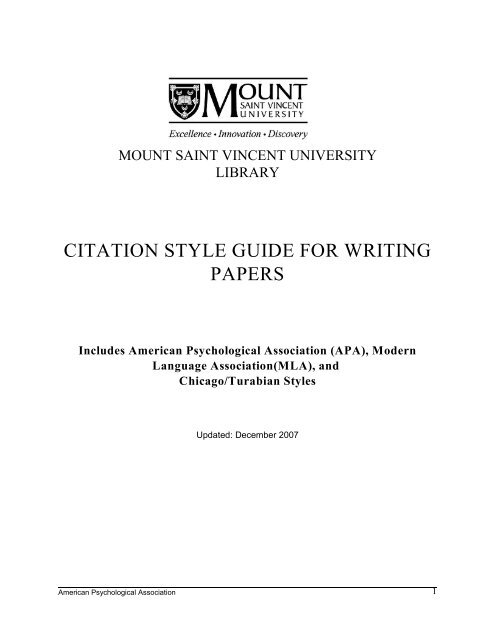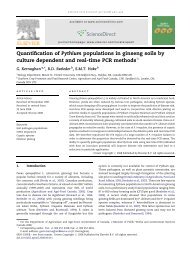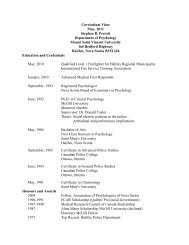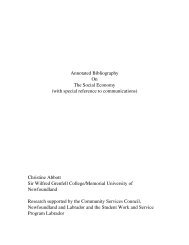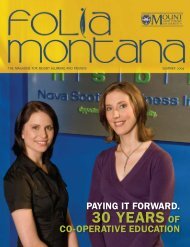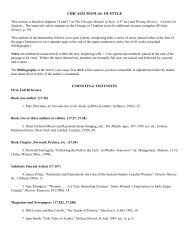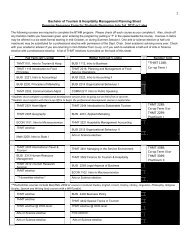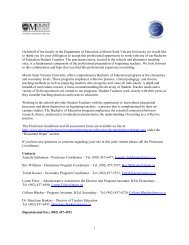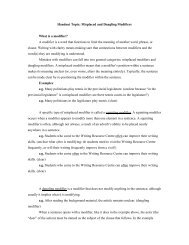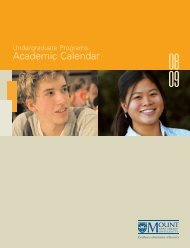citation style guide for writing papers - Mount Saint Vincent University
citation style guide for writing papers - Mount Saint Vincent University
citation style guide for writing papers - Mount Saint Vincent University
Create successful ePaper yourself
Turn your PDF publications into a flip-book with our unique Google optimized e-Paper software.
MOUNT SAINT VINCENT UNIVERSITY<br />
LIBRARY<br />
CITATION STYLE GUIDE FOR WRITING<br />
PAPERS<br />
Includes American Psychological Association (APA), Modern<br />
Language Association(MLA), and<br />
Chicago/Turabian Styles<br />
Updated: December 2007<br />
American Psychological Association<br />
1
This <strong>guide</strong> provides samples of the more common types of <strong>citation</strong>s using the American Psychological<br />
Association (APA), Modern Language Association (MLA), and Chicago <strong>style</strong>s. Please refer to the<br />
appropriate publication <strong>for</strong> further details on each <strong>style</strong>. All examples in this <strong>guide</strong> are from the books<br />
referenced below.<br />
When <strong>writing</strong> a term paper it is important to determine whether a particular method of <strong>citation</strong> is<br />
required. Please remember to consult your professor.<br />
If your professor specifies a particular method of <strong>citation</strong> follow the authoritative manual of <strong>style</strong>, such<br />
as:<br />
Publication Manual of the American Psychological Association. (5th ed.). (2001). Washington, DC:<br />
American Psychological Association.<br />
Call number: Ref. BF 76.7 P82 2001 (and on reserve at the Circulation Desk.)<br />
Gibaldi, Joseph. MLA Handbook <strong>for</strong> Writers of Research Papers. 6th ed. New York: Modern Language<br />
Association of American, 2003.<br />
Call number: Ref. LB 2369 G53 2003<br />
th<br />
The Chicago Manual of Style. 15 ed. Chicago: <strong>University</strong> of Chicago Press, 2003.<br />
Call number: Ref. LB 2369 C478 2003<br />
Storey, William Kelleher and Towser Jones. Writing History: A Guide <strong>for</strong> Students. Don Mills, ON:<br />
Ox<strong>for</strong>d <strong>University</strong> Press, 2004.<br />
Call number: Ref D16 S864 2004c (and on reserve at the Circulation Desk.)<br />
Turabian, Kate L. A Manual <strong>for</strong> Writers of Term Papers, Theses and Dissertations. 6 ed. Chicago:<br />
th<br />
<strong>University</strong> of Chicago Press, 1996.<br />
Call number: Ref. LB 2369 T8 1996<br />
American Psychological Association<br />
2
AMERICAN PSYCHOLOGICAL ASSOCIATION<br />
The “APA Manual” contains valuable advice on <strong>writing</strong> <strong>style</strong> and grammar, plus an important section<br />
dealing with the problems of sexist language and ethnic bias in <strong>writing</strong> psychology <strong>papers</strong> (sections 2.13-<br />
2.17). This brief <strong>guide</strong> deals specifically with editorial <strong>style</strong>, particularly the correct method of citing<br />
books and articles in your term <strong>papers</strong>.<br />
DIRECT QUOTATIONS<br />
(Section 3.34)<br />
A short quotation of less than 40 words should be incorporated into the text of your paper and enclosed<br />
in double quotation marks with a reference to the author of the work quoted, the year of publication, and<br />
the page from which the quotation is taken, enclosed in parentheses, together or separately, depending on<br />
how you have worked it into your text. This is known as the author-date method of <strong>citation</strong>.<br />
Example 1<br />
She stated, “The ‘placebo effect,’ . . . disappeared when behaviors were studied in this manner” (Miele,<br />
1993, p. 276), but she did not clarify which behaviors were studied.<br />
Example 2<br />
Miele (1993) found that “the ‘placebo effect,’ which had been verified in previous studies, disappeared<br />
when [only the first group’s] behaviors were studied in this manner” (p. 276).<br />
No quotation marks are used <strong>for</strong> block quotations, which are direct quotations of more than 40 words, set<br />
off from your text in freestanding blocks of typewritten lines, indented five spaces from the left margin.<br />
The entire quotation should be double-spaced.<br />
Example 3<br />
Miele(1993) found the following:<br />
The “placebo effect,” which had been verified in previous studies, disappeared when behaviors were<br />
studied in this manner. Furthermore, the behaviors were never exhibited again [italics added], even<br />
when reel [sic] drugs were administered. Earlier studies (e.g., Adullah, 1984; Fox, 1979) were clearly<br />
premature in attributing the results to a placebo effect. (p. 276)<br />
American Psychological Association<br />
3
INDIRECT QUOTATIONS (Reference Citations in Text)<br />
(Sections 3.39, 3.94-3.103)<br />
Even when you cite an author’s work indirectly, (that is, when you do not quote from it exactly but refer,<br />
in your own words, to that author’s ideas, research, conclusions, etc.), you must briefly identify your<br />
source.<br />
One Work By One Author (3.94)<br />
Example 1<br />
At an appropriate point in your text, simply insert between parentheses the last name of the author of the<br />
source to which you are referring and the date of its publication, separating the two by a comma and a<br />
space:<br />
Example 2<br />
In a recent study of reaction times (Rogers, 1994)<br />
If the author’s name has been worked into your text, only the date is needed in the parentheses:<br />
Example 3<br />
Rogers (1994) compared reaction times<br />
If the author’s name and date appear within your text, no parenthetical in<strong>for</strong>mation is needed:<br />
Example 4<br />
In 1994 Rogers compared . . .<br />
Within a paragraph, as long as the study cannot be confused with another cited study, it is not necessary<br />
to include the year in a subsequent reference:<br />
In a recent study of reaction times, Rogers (1994) described the method...Rogers also found...<br />
American Psychological Association<br />
4
One Work By Multiple Authors (3.95)<br />
When a work has two authors, always cite both surnames every time the reference occurs in your text.<br />
If there are three to five authors, cite all authors the first time. In subsequent references, cite only the<br />
surname of the first author followed by “et al.” and the year if it is the first <strong>citation</strong> of the reference<br />
within a paragraph.<br />
Example<br />
Wasserstein, Zappulla, Rosen, Gertman, and Rock (1994) found that the data are related. [First <strong>citation</strong>]<br />
Wasserstein et al. (1994) found...<br />
[subsequent <strong>citation</strong> per paragraph thereafter]<br />
[Omit the year from subsequent <strong>citation</strong>s after the first <strong>citation</strong> within a paragraph]<br />
Groups As Authors (3.96)<br />
The name of a group author is usually spelled out each time it appears in your text. The names of some<br />
authors are spelled out in the first <strong>citation</strong> and abbreviated thereafter. Use your judgement. The reader<br />
of your paper should be able to locate it and the complete <strong>citation</strong> of the work, without undue difficulty,<br />
in the reference list at the end of your paper.<br />
Example<br />
Entry in reference list:<br />
National Institute of Mental Health. (1991).<br />
First text <strong>citation</strong>:<br />
(National Institute of Mental Health [NIMH], 1991)<br />
Subsequent text <strong>citation</strong>:<br />
(NIMH, 1991)<br />
Authors With Same Surname (3.98)<br />
When a publication contains two or more primary authors with the same surname, include the first<br />
author’s initials in all text <strong>citation</strong>s, even when the year of publication is different.<br />
Example 1<br />
Example 2<br />
R.D. Luce (1954) and P.A. Luce (1986) also found<br />
J.M. Goldberg and Nerf (1961) and M.E. Goldberg and<br />
Wurtz (1972) studied<br />
American Psychological Association<br />
5
Specific Parts of a Source (3.101)<br />
In addition to the author and the date, indicate the page, chapter, figure, table, if necessary, at the<br />
appropriate point in your text. Page numbers should always be given <strong>for</strong> direct quotations.<br />
Example 1 (Cheek & Buss, 1981, p. 332)<br />
Example 2 (Shimamura, 1989, chap. 3)<br />
Citation of [Electronic] Sources (3.39)<br />
Example 1 (location reference used)<br />
Use <strong>for</strong> direct quotation or paraphrasing from electronic sources that do not provide page numbers, but<br />
do provide paragraph numbers. Use the paragraph number in place of the page number, preceded by or<br />
the abbreviation para.<br />
As Myers (2000, para. 5) aptly phrased it, “positive emotions are both an end - better to live<br />
fulfilled, with joy [and other positive emotions]- and a means to a more caring and healthy<br />
society.”<br />
Example 2 (location reference used)<br />
Use <strong>for</strong> direct quotation or paraphrasing when there are neither paragraph nor page numbers, but<br />
headings such as Introduction, Method, Results, Discussion, Conclusion are present. Cite the heading<br />
and the paragraph following the heading. This will direct the reader to the appropriate section.<br />
Beutler concludes that our existing managed care organizations, and the ways in which we<br />
approach treatments, are shortsighted (Beutler, 2000, Conclusion section, 1).<br />
Example 3 (no location reference)<br />
While this <strong>citation</strong> method can be used <strong>for</strong> direct quotation or paraphrasing, it is most appropriate <strong>for</strong><br />
direct quotations since documents accessed with a Web browser are searchable by using the ‘Find in<br />
Page’ command under Edit on the browser tool bar. You may choose to omit a location reference<br />
altogether when no page or paragraph numbers are provided, and headings either were not used or their<br />
use would prove confusing. In these cases cite only the author and date.<br />
“The current system of managed care and the current approach to defining empirically supported<br />
treatments are shortsighted” (Beutler, 2000).<br />
If you are unsure which method to use please consult with a librarian or your professor. Librarians may<br />
refer you to your professor.<br />
American Psychological Association<br />
6
E-mail (3.102)<br />
Email sent from one individual to another should be cited as a personal communication.<br />
T.K. Lutes (personal communication, April 18, 2001)<br />
(V.-G. Nguyen, personal communication, September 28, 1998)<br />
“Because they do not provide recoverable data, personal communications are not included in the<br />
reference list. Cite personal communications in text only. Give the initials as well as the surname of the<br />
communicator, and provide as exact a date as possible” (American Psychological Association, 2001, p.<br />
214).<br />
REFERENCE LIST<br />
(Sections 4.01- 4.16 and Appendix D)<br />
At the end of your paper you must provide full documentation <strong>for</strong> each source used to support the<br />
arguments in your paper. This includes every reference you provided in shortened <strong>for</strong>m within<br />
parentheses or in the body of your paper, whether <strong>for</strong> direct quotations or <strong>for</strong> indirect <strong>citation</strong>s.<br />
Entries in APA publications are listed in the reference section alphabetically, in author-date order. Legal<br />
th<br />
materials are cited in accordance with The Blue Book: A Uni<strong>for</strong>m System of Citation (17 ed., 2000). An<br />
abbreviated version of The Blue Book can be found in Appendix D of the APA Manual.<br />
The reference list must be double-spaced (examples here are single-spaced here to save space), and<br />
entries should have a hanging indent. Be accurate and complete. Pay particular attention to what is<br />
italicized and capitalized, and the punctuation.<br />
Scholarly Journal Article, one author (4.16, A, 1)<br />
Mellers, B. A. (2000). Choice and the relative pleasure of consequences. Psychological Bulletin, 126(6),<br />
910-924.<br />
Magazine Article (4.16, A, 6)<br />
Kandel, E. R., & Squire, L. R. (2000, November 10). Neuroscience: Breaking down scientific barriers to<br />
the study of brain and mind. Science, 290, 1113-1120.<br />
Newspaper Article, Discontinuous Pages (4.16, A, 10)<br />
If an article appears on discontinuous pages, give all page numbers and separate the numbers with a<br />
comma. (e.g., pp. B1, B3, B5-B7).<br />
Schwartz, J. (1993, September 30). Obesity affects economic, social status. The Washington Post, pp.<br />
A1, A4.<br />
American Psychological Association<br />
7
Citing an Abstract Only (4.16, A, 16)<br />
Woolf, N. J., Young, S. L., Fanselow, M. S., & Butcher, L. L. (1991). MAP-2 expression in<br />
cholinoceptive pyrimidal cells of rodent cortex and hippocampus is altered by Pavlovian<br />
conditioning [Abstract]. Society <strong>for</strong> Neuroscience Abstracts, 17(4), 480.<br />
Book (4.16, B)<br />
Beck, C. A. J., & Sales, B. D. (2001). Family mediation: Facts, myths, and future prospects. Washington,<br />
DC: American Psychological Association.<br />
Book, No Author Or Editor (4.16, B, 26)<br />
Merriam-Webster’s Collegiate Dictionary (10th ed.). (1993). Springfield, MA: Merriam-Webster.<br />
Article or Chapter in an Edited Book (4.16, B, 34)<br />
Bjork, R. A. (1989). Retrieval inhibition as an adaptive mechanism in human memory. In H. L. Roediger<br />
III & F. I. M. Craik (Eds.), Varieties of memory & consciousness (pp. 309-330). Hillsdale, NJ:<br />
Erlbaum.<br />
Book Review (4.16, G, 63)<br />
Schatz, B. R. (2000). Learning by text or context [Review of the book The social life of in<strong>for</strong>mation].<br />
Science, 290(5495),1304.<br />
Corporate Author, brochure (4.16, A, 33)<br />
Research and Training Center on Independent Living. (1993). Guidelines <strong>for</strong> reporting and <strong>writing</strong> about<br />
th<br />
people with disabilities (4 ed.) [Brochure]. Lawrence, KS: Author.<br />
Entire Encyclopedia or Dictionary (4.16, A, 30)<br />
th<br />
Sadie, S. (Ed.). (1980). The new Grove dictionary of music and musicians (6 ed., Vols. 1-20). London:<br />
Macmillan.<br />
Entry from an Encyclopedia or Dictionary (4.16, B, 38)<br />
Bergman, P. G. (1993). Relativity. In The new encyclopaedia Britannica (Vol. 26, pp. 501-508).<br />
Chicago: Encyclopaedia Britannica.<br />
Canadian Government Documents<br />
For general in<strong>for</strong>mation on citing Canadian Government Documents please see the MSVU library<br />
webpage at www.msvu.ca/library/govdocr.asp<br />
American Psychological Association<br />
8
ELECTRONIC MEDIA (From: APA Style Guide to Electronic Media at<br />
http://wwwdev.msvu.ca/library/PDFs/APAelectronic.pdf.)<br />
If you have questions about <strong>citation</strong> please consult with a librarian or your professor. Librarians may<br />
refer you to your professor.<br />
Important things to keep in mind:<br />
• Include the same <strong>citation</strong> elements (author, title, date, etc.) in the same order as you would <strong>for</strong> a<br />
print source, and add as much electronic retrieval in<strong>for</strong>mation as needed <strong>for</strong> others to locate the<br />
sources you cited. Direct readers as closely as possible to the source used and when in doubt<br />
follow the principle of providing more in<strong>for</strong>mation rather than less.<br />
• Issue number: always include the journal volume number and issue number (if available).<br />
• Retrieval dates: no longer required <strong>for</strong> content that is not likely to change (journal articles or<br />
books); retrieval dates are still required <strong>for</strong> undated or changeable content from the open web.<br />
• Use a journal article’s DOI (if available) instead of the URL in the reference. The DOI is a<br />
Digital Object Identifier that allows a reader to link directly to an article via the publisher’s web<br />
site.<br />
Journal Articles with an assigned DOI:<br />
Miller, P. H., & Aloise, P. A. (1989). Young children's understanding of the psychological causes of<br />
behavior: A review. Child Development, 60(2), 257-286. doi:10.1111/1467-8624.ep7266798<br />
<br />
An article’s DOI number can usually be found on the same web page as the abstract or in some<br />
cases with the <strong>citation</strong> or full article. DOIs can also be looked up at:<br />
www.crossref.org/guestquery<br />
Journal Articles with no assigned DOI:<br />
Electronic journal article retrieved from a database such as EBSCO’s Academic Search Premier:<br />
include database name.<br />
Jones, W. S. (1976). The manager's role in developmental planning. Training & Development<br />
Journal,30(7), 3-9.<br />
Retrieved from Academic Search Premier database.<br />
<br />
Based on in<strong>for</strong>mation provided in the APA Style Guide to Electronic Media (2007, p. 3), we<br />
recommend that you include the database name when an article is of limited circulation (i.e.,<br />
subscription-based) and is delivered by an electronic database.<br />
Subscription-based electronic journal article available only from publisher’s web site: include<br />
URL of journal home page.<br />
Lorenzen, J. K., Mølgaard, C., Michaelsen, K. F., & Astrup, A. (2006). Calcium supplementation <strong>for</strong> 1 y<br />
does not reduce body weight or fat mass in young girls. American Journal of Clinical Nutrition,<br />
83(1), 18-23. Retrieved from http://www.ajcn.org<br />
Open-access electronic journal article available from publisher’s web site: include exact ULR <strong>for</strong><br />
article.<br />
Li, Q. (2007). Mathematics, science, and technology in secondary schools: Do gender and region make a<br />
difference Canadian Journal of Learning and Technology, 33(1). Retrieved from<br />
http://www.cjlt.ca/ content/vol33.1/li.html<br />
<br />
Note: this article did not have page numbers. Indicate page numbers if they are present.<br />
American Psychological Association<br />
9
Newspaper article<br />
Hilts, P. J. (1999, February 16). In <strong>for</strong>ecasting their emotions, most people flunk out. The New York<br />
Times. Retrieved from http://www.nytimes.com<br />
Stand-alone web page document, no author identified, no date<br />
GVU's 8th WWW user survey. (n.d.). Retrieved August 8, 2000, from http://www.cc.gatech.edu/gvu/<br />
usersurveys/survey1997-10<br />
<br />
If the author of a document is not identified, begin the reference with the title of the document. The<br />
abbreviation n.d. is used when no date of publication is provided.<br />
White <strong>papers</strong> or documents available from an organization, university or departmental web site<br />
Chou, L., McClintock, R., Moretti, F., & Nix, D. H. (1993). Technology and education: New wine in new bottles:<br />
Choosing pasts and imagining educational futures. Retrieved August 24, 2000, from Columbia <strong>University</strong>,<br />
Institute <strong>for</strong> Learning Technologies: http://www.ilt.columbia.edu/publications/<strong>papers</strong>/newwine1.html<br />
<br />
If a document that presents an organization’s philosophy, position or policy is contained within a large and<br />
complex web site, identify the host organization and the relevant program or department be<strong>for</strong>e giving the<br />
URL <strong>for</strong> the document itself.<br />
ERIC Document<br />
Brewster, C., & Railsback, J. (2002). Full-day kindergarten: Exploring an option <strong>for</strong> extended learning. (ERIC<br />
Document Reproduction Service No. ED472733). Retrieved from Education Resources In<strong>for</strong>mation Center:<br />
http://www.eric.ed.gov/ERICDocs/data/ericdocs2sql/content_storage_01/0000019b/80/1a/bc/d4.pdf<br />
Electronic Book (open-access)<br />
Buchanan, R., & Koch-Schulte, S. (2000). Gender on the line: Technology, restructuring and the reorganization of<br />
work in the call centre industry. Ottawa: Status of Women Canada. Retrieved from http://www.swc-cfc.gc.<br />
ca/pubs/pubspr/0662281586/200010_0662281586_e.pdf<br />
<br />
For electronic books the publisher’s geographical location and name are generally not necessary if the<br />
publisher’s name is clear from the author name, URL, database name, or other reference in<strong>for</strong>mation. It is<br />
included here <strong>for</strong> clarification.<br />
Electronic Book (subscription-based)<br />
Bart, J. (2000). Women succeeding in the sciences: Theories and practices across disciplines. West Lafayette, IN:<br />
Purdue <strong>University</strong> Press. Available from http://www.netlibrary.com<br />
<br />
Use “Available from” instead of “Retrieved from” when the URL leads to in<strong>for</strong>mation on how to obtain the<br />
book rather than to the book itself.<br />
American Psychological Association<br />
10
Thesis or Dissertation retrieved from a subscription database<br />
Buckner, A. L. (2007). Appetite awareness training in the prevention of eating disorders. Retrieved from ProQuest<br />
Dissertations and Theses. (AAT 3273686)<br />
Thesis or Dissertation retrieved from Theses Canada Portal or university web site (open-access)<br />
Roth, D. H. (2004). Adult reflections on childhood verbal abuse. (Master’s thesis, <strong>University</strong> of Saskatchewan, 2004).<br />
Retreived from http://www.collectionscanada.ca/obj/s4/f2/dsk3/SSU/TC-SSU-07272004163726.pdf<br />
Wiki<br />
Market research. (2007, November 30). Retrieved 21:24, November 28, 2007, from Wikipedia, The Free<br />
Encyclopedia: http://en. wikipedia.org/w/index.phptitle=Marketing_research&oldid=173254885<br />
<br />
Note that APA places the retrieval date and time be<strong>for</strong>e the organization’s name. This is most similar to citing<br />
a general web page. See the Guide <strong>for</strong> examples of citing an electronic dictionary or encyclopedia that<br />
originated in print.<br />
Blog (Weblog)<br />
Giest, M. (2007, November 27). Universal Music CEO on Technology. Message posted to http://www.<br />
michaelgeist.ca/content/view/2413/196<br />
YouTube (Video post)<br />
Norton, R. (2006, November 4). How to train a cat to operate a light switch [Video file]. Video posted to<br />
http://www.youtube.com/watchv=Vja83KLQXZs<br />
American Psychological Association<br />
11
MODERN LANGUAGE ASSOCIATION (MLA)<br />
CITING SOURCES IN THE TEXT (6.1 - 6.5.2, pp. 237-260)<br />
The MLA Handbook recommends the use of parenthetical references in place of endnotes or footnotes. Parenthetical<br />
documentation/<strong>citation</strong> is used <strong>for</strong> direct and indirect quotation. When using parenthetical <strong>citation</strong>, give only enough<br />
in<strong>for</strong>mation to identify the print or electronic source. The reader will be able to identify full publication in<strong>for</strong>mation<br />
in the Works Cited or Works Consulted list. Works Consulted indicates that the list is not limited to the sources cited<br />
in your paper. It includes material you read, but to which you did not directly refer or quote.<br />
Work by One Author (6.1 - 6.3)<br />
Example 1 (Indirect quote, author’s name in text, 6.3)<br />
Tennen has argued this point (178-85).<br />
Example 2 (Direct quotation - less than four lines of text in your paper, 3.7.2 and 6.1)<br />
Medieval Europe was a place both of “raids, pillages, slavery, and extortion” and of “travelling merchants, monetary<br />
exchange, towns if not cities, and active markets in grain” (Townsend 10).<br />
Example 3 (Direct quotation - more than four lines of text in your paper, 2.7.1 and 6.3)<br />
John K. Mahon adds a further insight to our understanding of the War of 1812:<br />
Financing the war was very difficult at the time. Baring Brothers, a banking firm of the enemy country,<br />
handled routine accounts <strong>for</strong> the United States overseas, but the firm would take on no loans. The loans were<br />
in the end absorbed by wealthy Americans at great hazard – also, as it turned out, at great profit to them.<br />
(385)<br />
Double-space indented quotations, indent one inch or 10 spaces from the left margin, and do not use quotation marks.<br />
Entries in Mulitvolume Works (encyclopeadias, anthologies) (6.4.3)<br />
“An evolutionary history of criticism must fail. I have come to this resigned conclusion” (Wellek, 5: xxii).<br />
[Author/Editor, volume: page number]<br />
MLA<br />
12
Corporate Authors (6.4.5)<br />
According to a study sponsored by the National Research Council, the population of China around 1990 was<br />
increasing by more than fifteen million annually (15).<br />
Try to work a long corporate author’s name into the body of the text so that the reading is not interrupted. If you are<br />
giving the name of a corporate author in parentheses, you may shorten terms that are commonly abbreviated, i.e.,<br />
(Natl. Research Council 15), (see 7.4).<br />
No Author, Citing by Title (6.4.4)<br />
Even Sixty Minutes launched an attach on modern art (“Yes . . . but Is It Art”).<br />
In the Works Cited list this would be referenced as follows:<br />
“Yes . . . but Is It Art” Narr. Morley Safer. Sixty Minutes. CBS. WCBS, New York. 19<br />
Sept. 1993.<br />
More than One Author (6.2, p. 239)<br />
Two Authors<br />
Among intentional spoonerisms, the “punlike metathesis of distinctive features may serve to weld together words<br />
etymologically unrelated but close in their sound and meaning” (Jakobson and Waugh 304).<br />
Three authors:<br />
(Rabkin, Greenberg, and Olander vii)<br />
More than three authors:<br />
(Lauter et al. 2425-33)<br />
Citing Indirect Sources (6.4.7)<br />
Whenever possible, take material from the original source, not a secondhand one. When this is not possible, put the<br />
abbreviation qtd. in (“quoted in”) be<strong>for</strong>e the indirect source. List the original and secondary source in the “Works<br />
Cited” list.<br />
Samuel Johnson admitted that Edmund Burke was an “extraordinary man” (qtd. in Boswell 2: 450).<br />
MLA<br />
13
Electronic Source (i.e., article from Ebsco, Academic Search Premier)<br />
Just as with print sources, when you use electronic sources you are required to indicate where you derived an idea or<br />
an exact quote. Please refer to the MLA Handbook, section 6.4.1-6.4.4, <strong>for</strong> examples of non-print sources such as<br />
films, television programs, or recordings. Examples provided here focus on electronic journal articles.<br />
If your source includes page or paragraph numbers cite the relevant numbers by giving the appropriate abbreviation<br />
be<strong>for</strong>e the numbers.<br />
Example 1 (Author and paragraph numbers included in article)<br />
(Moulthrop, pars. 19-20)<br />
Example 2 (Author and page numbers included, such as with a PDF article)<br />
“I had long been impatient with the barrenland snowscape cliche that Hollywood uses so often to characterize my<br />
home country” (New 566).<br />
Example 3 (No pagination or paragraph numbers)<br />
When a web document does not have fixed page numbers or paragraph numbering, you must omit numbers from your<br />
parenthetical references and cite the entire work. The MLA Handbook, sec. 6.4.1, suggests that you work into the<br />
body of your text the name of the person (author, editor, per<strong>for</strong>mer).<br />
a) Michael Joyce was among the first to write fiction in hypertext.<br />
b) William J. Mitchell’s City of Bits discusses architecture and urban life.<br />
Note: if you have printed a web document or article, the page numbers of your printout should not be cited because<br />
the pagination will vary <strong>for</strong> different printers. If page numbers are included as part of the article, as is the case with<br />
PDF files, you should use the page numbers.<br />
Books: One author (5.6.1)<br />
WORK CITED LIST (5.1-5.9.9)<br />
Pollack, Vivian R. Dickinson: The Anxiety of Gender. Ithaca: Cornell UP, 1984.<br />
Two or three authors (5.6.4)<br />
Blocker, Clyde E., Robert H. Plummer and Richard C. Richardson, Jr. The Two-Year College: A Social Synthesis.<br />
Englewood Cliffs: Prentice, 1965.<br />
More than three authors (5.6.4)<br />
Quirk, Randolph, et al. A Comprehensive Grammar of the English Language. London: Longman, 1985.<br />
MLA<br />
14
Books: An Anonymous work (5.6.11)<br />
New York Public Library Student’s Desk Reference. New York: Prentice, 1993.<br />
An Edition (5.6.12, 5.6.14)<br />
Shakespeare, William. Hamlet. Ed. Barbara A. Mowat and Paul Werstine. New York: Washington Square-Pocket,<br />
1992. [Ed. refers to “Edited by”.]<br />
rd<br />
Bondanella, Peter. Italian Cinema: From Neorealism to the Present. 3 ed. New York: Continuum, 2001.<br />
A Work in an Anthology or a Chapter (5.6.7)<br />
Calvino, Italo. “Cybernetics and Ghosts.” The Uses of Literature: Essays. Trans. Patrick Creagh. San Diego: Harcourt,<br />
1982. 3-27.<br />
Article in a Scholarly Journal with Continuous Pagination (5.7.1)<br />
Craner, Paul M. “New Tool <strong>for</strong> an Ancient Art: The Computer and Music.” Computers and the Humanities 25 (1991):<br />
303-13.<br />
Article in a Scholarly Journal that Pages Each Issue (5.7.2)<br />
Barthelme, Frederick. “Architecture.” Kansas Quarterly 13.3-4 (1981): 77-80.<br />
Magazine Article (5.7.6)<br />
Bazell, Robert. “Science and Society: Growth Industry.” New Republic 15 Mar. 1993: 13-14.<br />
Newspaper Article (5.7.5)<br />
Manegold, Catherine S. “Becoming a Land of the Smoke-Free, Ban by Ban.” New York Times 22 Mar. 1994, late ed.:<br />
A1+.<br />
Review (5.7.7)<br />
Updike, John. “No Breaks.” Rev. of Sinclair Lewis: Rebel from Main Street, by Richard Lingeman. New Yorker 4<br />
Feb. 2002: 77-80.<br />
MLA<br />
15
Electronic Resources (5.9, pp. 207-235. See this section <strong>for</strong> pagination in<strong>for</strong>mation.)<br />
Full-Text Article from an online database, i.e., Academic Search Elite (5.9.7)<br />
Berek, Peter. “Cross-Dressing, Gender, and Absolutism in the Beaumont and Fletcher Plays.” Studies in English<br />
Literature 44 (2004): 359- . Academic Search Premier. EBSCO. <strong>Mount</strong> <strong>Saint</strong> <strong>Vincent</strong> <strong>University</strong> Library,<br />
Halifax, NS. 17 Aug. 2004 .<br />
Full-Text Journal Article (5.9.4)<br />
Sohmer, Steve. “12 June 1599: Opening Day at Shakespeare’s Globe.” Early Modern Literary Studies 3.1 (1997): 46<br />
pars. 26 June 2002 .<br />
Scholarly Project (5.9.2 )<br />
Victorian Women Writers Project. Ed. Perry Willett. May 2002. Indiana U. 7 June 2002<br />
.<br />
Personal Homepage (5.9.2 c.)<br />
Lancashire, Ian. Home page. 1 Mar. 2002. 26 July 2003 .<br />
Material from a CD-ROM (5.9.5)<br />
nd<br />
“Jazz.” The Ox<strong>for</strong>d English Dictionary. 2 ed. CD-ROM. New York: Ox<strong>for</strong>d UP, 1992.<br />
MLA<br />
16
CHICAGO MANUAL OF STYLE<br />
th<br />
This section is based on chapters 16 and 17 of The Chicago Manual of Style (15 ed.) and Writing History: A Guide<br />
<strong>for</strong> Students. The latter title refers students to the Chicago or Turabian <strong>style</strong> <strong>for</strong> additional <strong>citation</strong> examples (Writing<br />
History, p. 39).<br />
This method of documentation follows a two-part system, comprising both a series of notes, placed either at the foot<br />
of the page (footnotes) or on a separate page at the end of the paper (endnotes), and a list of all works consulted<br />
(bibliography).<br />
Notes are numbered consecutively within the text, beginning with 1. Use superscript numbers¹ placed at the end of<br />
the passage to be cited. Within the notes themselves, numbers are normally full size, not raised, and followed by a<br />
period and a space.<br />
The Bibliography at the end of your essay lists ALL of the sources you have consulted, in alphabetical order by<br />
author (last name first) or title (if the author is unnamed).<br />
ENDNOTES or FOOTNOTES<br />
First, Full Reference<br />
Book, one author (17.26)<br />
1. Max Plowman, An Introduction to the Study of Blake (London: Gollancz, 1982), 32.<br />
Book, two or three authors or editors (17.27, 17.28)<br />
2. Dana Carleton Munro and Raymond James Songtag, eds., The Middle Ages, 395-1500, rev. ed., Century<br />
Historical Series (New York and London: Century, 1928), 69.<br />
Book Chapter, Forward, Preface, etc. (17.69)<br />
3. Norwald Torrington, “Following the Path to the Left,” in Whither Tomorrow ed. Montgomery Abelson,<br />
11-12 (Tulsa: Wizmer Bros., 1994).<br />
Scholarly Journal Article (17.157)<br />
4. Janice Potter, “Patriarchy and Paternalism: the Case of the Eastern Ontario Loyalist Women,” Ontario<br />
History 81, 1 (March 1989): 17.<br />
5. Jane Errington, "’ Women . . . is a Very Interesting Creature’: Some Women’s<br />
Experiences in Early Upper Canada,” Historic Kingston, 38 (1990): 18.<br />
Chicago Manual of Style<br />
17
Magazines and News<strong>papers</strong> (17.182, 17.188)<br />
6. Bob Levine and Rae Corelli, “The Tracks of History,” Maclean’s, 6 July 1992, 18.<br />
7. Jane Smith, “Folk Tales of Acadia,” Halifax Herald, 26 July 1949, sec. A, p. 4.<br />
Canadian Government Document (17.325)<br />
8. Canada, House of Commons Debates (3 June 2000), p. 7904 (Mrs. Lalonde, MP).<br />
9. Canada Wildlife Act, RSC 1985, c. W-9, s. 1.<br />
Archival Documents, Manuscripts and Unpublished Material (17.214, 17.222)<br />
10. Mary James to Celia Johnston, 14 and 30 July 1916, Johnston Letters, Acadian Women’s Collection, Nova<br />
Scotia Public Archives.<br />
11. Nancy Delayen, “The Fabian Society and Eugenics, 1885-1914" (MA thesis, <strong>University</strong> of Saskatchewan,<br />
1998), 57.<br />
Encyclopedia or Dictionary Article (17.239)<br />
Well-known reference books are usually not cited in reference lists, but are cited within the text. When they are cited in<br />
notes, the facts of publication (place of publication, date and publisher) are usually omitted. The edition, if not the first,<br />
must be specified.<br />
12. Encyclopedia Americana, 1963 ed., s.v. “Sitting Bull.”<br />
Note: s.v. is from the Latin sub verbo meaning “under the word”.<br />
Electronic Documents<br />
See the Chicago Manual of Style (17.180, 17.187, 17.234, 17.357) and Writing History: A Guide <strong>for</strong> Students, (p. 42) <strong>for</strong><br />
other examples of citing electronic sources. The Chicago Manual of Style does not require < . . . > around URLs but it does<br />
require the use of the word “accessed”; this differs from Writing History.<br />
Website (17.234)<br />
Chicago Style:<br />
13. Susan Merritt, “Dr. Maude Abbott,” Women From Canada’s Past, http://www.niagara.com/~ merrwill/<br />
default.html (accessed 10 August 2004).<br />
Writing History Style:<br />
14. Susan Merritt, “Dr. Maude Abbott,” Women From Canada’s Past, (10 August 2004).<br />
Chicago Manual of Style<br />
18
Newspaper Website (17.198)<br />
15. “Threats,” British Colonists, 3 June 1869. Who Killed Robinson, http://web.uvic.ca/historyrobinson/indexmsn.html<br />
(accessed 17 Aug. 2003).<br />
Full-Text Article from an online database, i.e., Academic Search Premier (17.357)<br />
16. Nicholas Orme, “Child's Play in Medieval England,” History Today 51, no. 10 (2001): 49,<br />
http://search.epnet.com/ (accessed 17 December 2002).<br />
Dictionary of Canadian Biography Online (www.biographi.ca)<br />
17. Carman Miller, “Joseph Abbott,” Dictionary of Canadian Biography, Vol. IX,<br />
http://www.biographi.ca/EN/ShowBio.aspBioId=38385 (accessed 13 August 2004).<br />
Video Recording<br />
18. No Time For Tears: Vietnam, the Women Who Served (video-recording),<br />
directed by Elizabeth Bouiss (West End Film Production, 1993).<br />
Subsequent Shortened References (16.45)<br />
Use <strong>for</strong> a previously cited work that does not immediately precede the current <strong>citation</strong>. Include the author’s last name, title<br />
(or shortened title) and page number when required.<br />
Book (16.42)<br />
19. Plowman, Study of Blake, 125.<br />
Journal (17.179)<br />
20. Backhouse, "Married Women’s Property Law,” 212.<br />
Government Document<br />
21. Journals, 1852-53, Part I, 2-3.<br />
Ibid. (16.47)<br />
When references to the same work follow each other without any other reference in between, the abbreviation Ibid., from<br />
the Latin, ibidem, meaning “in the same place” may be used.<br />
For example, a second mention of the same page of Plowman’s work, with no intervening reference, requires only ibid.<br />
22. Ibid.<br />
If there is no intervening reference and the second reference to Plowman’s work is <strong>for</strong> a different page then the reference<br />
would be<br />
23. Ibid., 68.<br />
Op. Cit. and loc. cit. are no longer recommended <strong>for</strong> use (16.50).<br />
BIBLIOGRAPHY<br />
Chicago Manual of Style<br />
19
Books, single author or editor (17.26)<br />
Franklin, John Hope. George Washington Williams: A Biography. Chicago: <strong>University</strong> of Chicago Press, 1985.<br />
Books, two or more authors or editors (17.28-17.30)<br />
Stockwell, R.P., P. Schacter, and B.H. Partee, eds. The Major Syntactic Structures of English. New York: Holt, Rinehart<br />
and Winston, 1973.<br />
An Anonymous Work (17.32, 17.33)<br />
The Wind. New York: Harper, 1925.<br />
Edition other than the first (17.79)<br />
Bober, M. M. Karl Marx’s Interpretation of History. 2nd ed. Harvard Economic Studies. Cambridge: Harvard <strong>University</strong><br />
Press, 1948.<br />
Chapter in a Book (17.68-17.75)<br />
Rachels, James. “No Moral Difference.” In Ethics <strong>for</strong> Modern Life, edited by Raziel Abelson and Marie-Louise<br />
Friquegnon, 167-173. New York: St. Martin’s Press, 1991.<br />
Scholarly Journal Article (17.157, 17.163)<br />
Jackson, Richard. “Running Down the Up-Escalator: Regional Inequality in Papua New Guinea.” Australian Geographer<br />
14 (May 1979): 175-84.<br />
Smith, Lawrence P. “Sailing Close to the Wind.” Politics in Action 10, no. 4 (1993): 80-91.<br />
Magazine Article (17.182)<br />
Weber, Bruce. “The Myth Maker: The Creative Mind of Novelist E. L. Doctorow.” New York Times Magazine, 20<br />
October 1985, 42.<br />
Archival Documents, Manuscripts and Unpublished Material (17.214, 17.222)<br />
Murphy, Priscilla Coit. “What a Book Can do: Silent Spring and Media-Borne Public Debate.” PhD diss., <strong>University</strong> of<br />
North Carolina, 2000.<br />
Women’s Organization <strong>for</strong> National Prohibition Re<strong>for</strong>m Papers. Alice Belin du Pont files, Pierre S. du Pont Papers.<br />
Eleutherian Mills Historical Library, Wilmington, DE.<br />
Chicago Manual of Style<br />
20
Micro<strong>for</strong>m Collections (17.242)<br />
Micro<strong>for</strong>m collections, (Gerritsen and History of Women) that are used only to preserve printed material need not be<br />
mentioned in a <strong>citation</strong>. The source is treated as it would be in its print <strong>for</strong>mat. The following item is part of the History<br />
of Women collection:<br />
Biddle, Ellen McGowan. Reminiscences of a Soldier's Wife. Philadelphia: Press of J.B. Lippincott Co., 1907.<br />
Government Document (17.325)<br />
Citations should begin with “Canada” unless it is obvious from the context.<br />
Canada. Manitoba. Legislative Assembly. Debates and Proceedings, 17 August 2000.<br />
nd<br />
th<br />
Bill C-40. Extradition Act, 2 session, 36 Parliament, 1998. cl. 1 (assented to 17 June 1999). Statutes of Canada. 1999,<br />
c.18.<br />
Entry in an Encyclopedia or Dictionary (17.239)<br />
Well-known reference books are not listed in bibliographies. See “Endnotes or Footnotes” entry. The exception to this is<br />
the Dictionary of Canadian Biography. See entry below<br />
Video Recording<br />
No Time For Tears: Vietnam, the Women Who Served (videorecording). Directed by<br />
Elizabeth Bouiss. West End Film Production, 1993.<br />
Electronic Documents (17.180, 17.187, 17.234, 17.357)<br />
Website (17.234)<br />
Chicago Style:<br />
Merritt, Susan. “Dr. Maude Abbott.” Women From Canada’s Past. http://www.niagara.com/~ merrwill/default.html<br />
(accessed 10 August 2004).<br />
Writing History Style:<br />
Merritt, Susan. “Dr. Maude Abbott.” Women From Canada’s Past. (10<br />
August 2004).<br />
Newspaper Website (17.198)<br />
“Threats.” British Colonists. 3 June 1869. Who Killed Robinson http://web.uvic.ca/history-robinson/indexmsn.html<br />
(accessed 17 Aug. 2003).<br />
Full-Text Article from an online database, i.e., Academic Search Premier (17.357)<br />
Orme, Nicholas. “Child's Play in Medieval England.” History Today 51, no. 10 (2001): 49. http://search.epnet.com/<br />
(accessed 17 December 2002).<br />
Dictionary of Canadian Biography Online<br />
Miller, Carman. “Joseph Abbott.” Dictionary of Canadian Biography, Vol. IX.<br />
http://www.biographi.ca/EN/ShowBio.aspBioId=38385 (accessed 13 August 2004).<br />
Chicago Manual of Style<br />
21


